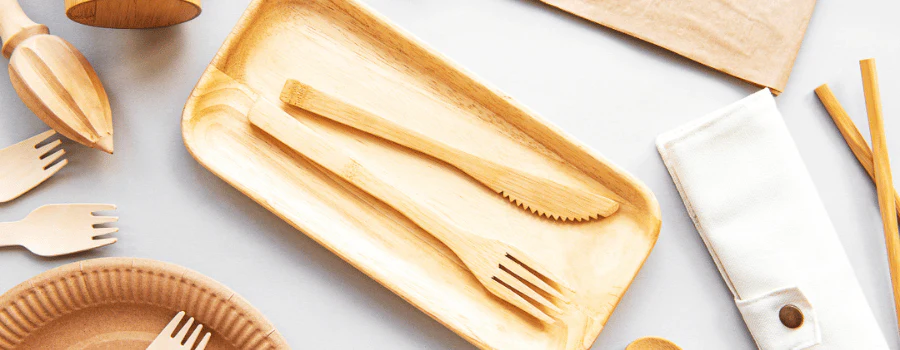
The Eco-Friendly Journey of Bamboo Cutlery
2023-12-29 17:25
Disposable plastic utensils exact a heavy toll on the environment, requiring significant energy for production, only to end up discarded after a single use. In the face of current climate challenges, it is essential that we shift towards non-toxic, biodegradable and plant-based materials. This is where bamboo cutlery shines. When manufactured properly, disposable bamboo cutlery exhibits the same durability as plastic without harming the planet. Its lifecycle respects the environment at every step. Let's delve into the phases of this eco-conscious journey.
Phase 1: Bamboo Growth & Harvesting
Our journey with disposable bamboo cutlery begins in bamboo forests. We meticulously source materials from regions certified by the Forest Stewardship Council, an agency committed to responsible forest management and harvesting. Unlike plastic utensils, which rely on finite resources like oil that take millions of years to form, bamboo cutlery relies on renewable bamboo plants. When a bamboo stalk is harvested, a new one sprouts in its place. This sustainable cycle ensures the environment remains unharmed, while we have the materials required for our disposable bamboo cutlery. These materials are not only easy to process due to their inherent strength but also grow rapidly. Bamboo takes just 5 years to fully regenerate, a stark contrast to birchwood which takes 30 years!
Phase 2: Processing
Even before reaching consumers, disposable bamboo cutlery lightens the environmental load. Plastic production consumes vast amounts of water, energy, and oil, leaving behind a trail of harmful chemicals. In comparison, bamboo leaves minimal ecological footprint, with no toxic residues. When comparing five major environmental factors of manufacturing, bamboo cutlery outperforms plastic and bioplastic in every aspect:
~They produce zero harmful byproducts.
~They require minimal water, if any.
~Their energy consumption throughout their lifecycle is significantly lower.
~They have a smaller global warming footprint.
~They release less carbon dioxide into the atmosphere.
~This data underscores the fact that creating new products can be eco-friendly and safe. Manufacturers do not need to exacerbate pollution to craft superior utensils.
Phase 3: Use
Like other single-use utensils, disposable bamboo cutlery is commonly found in many foodservice and hospitality establishments, used both in-house and provided with takeout orders. Beyond their aesthetic appeal, bamboo cutlery offers unmatched functionality.When crafted correctly, disposable bamboo cutlery embodies the best qualities of plastic cutlery while eliminating the negatives. These utensils not only benefit the environment and a restaurant's image but also provide durability, comfort, and suitability for various foods. Their period of use is positive and reliable.While single-use plastic utensils quickly wear out and cannot be safely reused, disposable bamboo cutlery maintains its functionality after a simple rinse. If desired, it can even be washed and reused before disposal.
Phase 4: Disposal & Composting
After dutifully serving their purpose, disposable bamboo cutlery is ready for disposal. Thankfully, they do not share the same fate as other single-use utensils, which often clog landfills and emit potent greenhouse gasses.
Bamboo cutlery can be fully composted, just like food scraps, coffee grounds, leaves, and branches. When combined with other organic materials, they enrich the soil as compost. This recycling process ensures nutrients return to the ground, rather than being released as carbon dioxide, which can linger in the atmosphere for up to 1,000 years. Whether done on a commercial level by restaurants or in a consumer's backyard, composting bamboo cutlery is a responsible choice.
If disposable bamboo cutlery accidentally ends up in the trash instead of being sorted with compost, it may reach a landfill. While not ideal, natural decomposition ensures that it won't stay there for long.
Phase 5: End of Life & Decomposition
Once disposed of, bamboo cutlery nears the end of its lifecycle, outperforming its plastic counterparts one last time. Bamboo is entirely natural and thus fully biodegradable, breaking down rapidly. In contrast, every plastic & bioplastic utensil ever manufactured likely still exists today. Plastic utensils do not biodegrade or compost, and even when placed in recycling bins, they may still end up in landfills due to their limited repurposing options. Plant-based plastic utensils are sometimes presented as a trendy alternative to regular plastic because they can be composted in industrial facilities. However, they are still not biodegradable. Most plastic utensils end up in the trash, ultimately mirroring the fate of their traditional counterparts - trapped in landfills, never breaking down. In conclusion, disposable bamboo cutlery is not only an eco-conscious choice but also a practical, durable, and functional alternative to traditional plastic utensils. Its life cycle reflects a commitment to environmental responsibility, making it a vital step in reducing plastic waste and embracing a greener future.

Get the latest price? We'll respond as soon as possible(within 12 hours)







